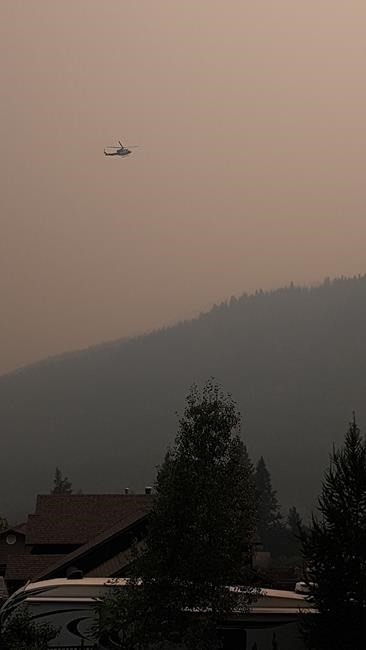A resident of a small British Columbia community devastated by wildfire says she and others want to return home to see what remains of their properties and businesses.
The community of Monte Lake, in B.C.'s central Interior, was hit by a wind-fanned wildfire last week that chased out residents and destroyed homes and businesses.
Victoria Cawkwell said she saw the fire approach her poultry farm and home.
"We were there for two hours watering everything down. We watched the fire come over the hill. It was an inferno, with 100-foot-high flames. We screamed for our lives, we screamed at our neighbours, hopped in our pickups and drove in the opposite direction hoping we were in time," she said in an interview.
Cawkwell, along with friends Lindsay Madsen and Ashlynn Kruesel, said their husbands have gone back to the community to fight the fires and to try to save what remains.
"It feels like a war zone. Some properties look like a bomb's been dropped. There's just a big hole in the ground," Cawkwell said.
Public Safety Minister Mike Farnworth has faced criticism from locals after chastising those who stayed behind to protect their property only to need rescuing by crews from the BC Wildfire Service.
Cawkwell said she wanted to offer Farnworth and Premier John Horgan a chance to come to her home for coffee and look out to see the devastation left by the wildfire.
"I want them to look out my window and look at a desolate, bare, blackened, horrible nightmare that I will have to live for the rest of my life," she said. "We have nothing."
Farnworth declined to comment.
Cawkwell said the community has also been hurt by the inaction of BC Wildfire Service management in working to better protect or save properties.
"If they're not going to protect our homes, we want to go home. We want to go home now and do what we can," she said.
Cawkwell said she wasn't given any warning by crews that the wildfire had crossed the highway and was heading towards her home or that she needed to leave.
Rick Manwaring, the deputy minister in the Ministry of Forests, Lands and Natural Resources, said the government is "quite confident" there was enough warning given to residents to evacuate.
He added that people need to follow evacuation alerts and orders, and the thought of someone dying from a wildfire "terrifies" him.
"The danger persists, and we just really want to recommend people respect the orders," he said at a Tuesday news conference.
The same massive fire that destroyed Monte Lake continues to burn between Kamloops and Okanagan Lake.
The Thompson-Nicola Regional District downgraded an evacuation order to an alert late Monday for about 400 properties threatened by fire.
Properties from the outskirts of Kamloops east to Chase are affected by the downgrade, while two other local governments replaced evacuation orders with alerts in and around the communities of Falkland and Fintry.
The BC Wildfire Service said the White Rock Lake fire remains out of control and evacuation orders continue for the communities of Monte Lake and Westwold.
Since April 1, there have been more than 1,400 wildfires in the province, burning 6,527 square kilometres. There are more than 53 evacuation orders for areas across the province, affecting roughly 6,000 properties. Residents in more than 31,000 properties have been placed on evacuation alert, meaning they may have to leave with little notice.
The wildfire service reports five new fire starts over the last two days, dropping the total number of wildfires to about 260. But there's concern another hot spell due to arrive Wednesday will ramp up the fire danger.
Forests Minister Katrine Conroy said the government is using all its resources to fight the fires across the province, but adds that climate change is leading to drier, hotter conditions.
Environment Canada has issued special weather statements covering inland sections of the north and central coasts, parts of Vancouver Island, the inner south coast and southern Interior, calling for heat in the mid- to high-30s, with little overnight relief until the weekend.
This report by The Canadian Press was first published Aug. 10, 2021.
Nick Wells, The Canadian Press



